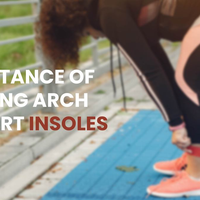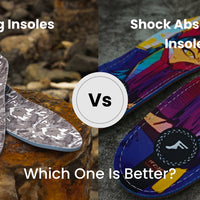Choosing the Right Support: A Guide to Selecting the Perfect Insoles

When it comes to foot comfort and support, selecting the right insoles is crucial. Insoles, also known as shoe inserts, are designed to provide additional cushioning, arch support, and stability to enhance your footwear experience. There are various types of insoles available in the market, each catering to specific foot conditions and activities. Understanding the different options and how they can benefit you is essential in making an informed decision. Here are some common types of insoles and their benefits:
-
Cushioning insoles: These insoles are designed to provide extra shock absorption and cushioning for activities that involve a lot of impact, such as running or hiking. They can help reduce fatigue and discomfort in your feet, ankles, and knees by absorbing the shock from each step.
-
Arch support insoles: If you have flat feet or high arches, arch support insoles can help provide additional support and stability to your feet. They help distribute your body weight evenly and promote proper alignment, reducing the risk of overpronation or supination.
-
Orthotic insoles: Orthotic insoles are specially designed to correct specific foot issues, such as plantar fasciitis, bunions, or metatarsalgia. They are typically prescribed by a podiatrist and are custom-made to fit your unique foot shape and address your specific needs.
-
Insoles for athletic shoes: If you engage in sports or high-intensity activities, specialized insoles for athletic shoes can improve your performance and reduce the risk of injuries. These insoles are designed to provide targeted support, stability, and shock absorption for specific sports like basketball, tennis, or soccer.
- Gel insoles: Gel insoles are made of soft, flexible materials that provide cushioning and comfort to your feet. They can help relieve pressure points, reduce friction, and prevent blisters or calluses from forming.
When choosing insoles, it's essential to consider your foot type, the activities you engage in, and any specific foot conditions you may have. It's always best to consult with a healthcare professional or a podiatrist to determine the right type of insoles for your needs. Investing in quality insoles can make a significant difference in your foot comfort and overall well-being.
Types of Insoles to Consider
Different Types of Insoles and Their Benefits
Insoles come in a range of styles and materials, including memory foam, gel, and rigid orthotic insoles. Memory foam insoles mold to the shape of your foot, providing personalized comfort. Gel insoles offer cushioning and shock absorption, making them suitable for high-impact activities. Rigid orthotic insoles are designed to provide maximum support for conditions such as flat feet or plantar fasciitis. When choosing the right insoles for you, consider your specific foot needs and the activities you participate in. If you have flat feet or experience foot pain, rigid orthotic insoles may be the best option for you. If you are looking for extra cushioning and shock absorption during running or other high-impact activities, gel insoles may be the way to go. Memory foam insoles are great for everyday comfort and support.
It's important to properly size and trim your insoles to fit your shoes. Insoles that are too big or too small can cause discomfort and may not provide the support you need. Additionally, be sure to replace your insoles regularly, as they can wear out over time and lose their effectiveness.
Choosing the Right Insole for Your Foot Arch Type
It is crucial to select an insole that aligns with your foot arch type to ensure proper support and alignment. For individuals with low arches, arch support insoles with a deep heel cup are recommended to prevent overpronation. Those with high arches should opt for cushioned insoles to distribute pressure evenly across the foot. It is also important to consider the material of the insole when choosing the right one for your foot arch type. Look for insoles made of supportive materials such as foam, gel, or cork, which can help provide stability and cushioning where needed. Additionally, make sure the insole fits properly in your shoes to prevent any discomfort or rubbing.

If you are unsure of your foot arch type, it may be helpful to consult a podiatrist or foot specialist who can assess your feet and recommend the best insole for your needs. Remember, proper support and alignment from your insoles can go a long way in preventing foot pain and discomfort in the long run.
Factors to Consider When Selecting Insoles for Specific Activities
When choosing insoles for specific activities such as running or hiking, factors like cushioning, breathability, and durability come into play. Running insoles are designed to provide impact protection and stability, while hiking insoles focus on cushioning and support for longer durations of walking on varied terrains. When selecting insoles for running, it's important to look for ones with ample cushioning to absorb the shock of each foot strike. Look for materials such as gel or foam that provide both cushioning and energy return to help propel you forward.
Additionally, running insoles should provide arch support to help distribute weight evenly and prevent overpronation.
Hiking insoles, on the other hand, should focus more on support and stability. Look for insoles with a firm arch support to help prevent fatigue and reduce the risk of injuries on uneven terrain. Good hiking insoles will also have a deep heel cup to help keep your foot in place and prevent slippage inside your shoe.
Breathability is also an important factor to consider when choosing insoles for either activity. Look for materials that are moisture-wicking and allow for good airflow to help keep your feet dry and comfortable, especially on longer runs or hikes.
Durability is another key consideration, especially if you plan to use the insoles on a regular basis. Look for insoles made from sturdy materials that can withstand the rigors of your chosen activity without breaking down prematurely.
Ultimately, the best insoles for running or hiking will depend on your individual needs and preferences. It may take some trial and error to find the perfect fit, but investing in high-quality insoles can make a significant difference in the comfort and performance of your feet during these activities.
Understanding the Importance of Insoles
How Insoles Help with Foot Pain Relief
If you experience foot pain, the right insoles can make a significant difference in alleviating discomfort. Insoles designed for conditions like flat feet and plantar fasciitis provide targeted support to reduce strain on the feet and promote proper alignment, ultimately relieving pain. There are several different types of insoles available, so it's important to choose the right ones for your specific needs. Here are some popular options to consider:
-
Arch Support Insoles: These insoles are designed to provide extra support and cushioning to the arch of the foot, which can help alleviate pain associated with flat feet or fallen arches.
-
Gel Insoles: Gel insoles are great for providing all-day comfort and cushioning. They can help absorb shock and reduce pressure on the feet, making them a good choice for those who are on their feet for long periods of time.
-
Orthotic Insoles: These insoles are designed to correct foot misalignments and provide support for conditions like plantar fasciitis, heel pain, and overpronation. They can help improve foot function and reduce pain by promoting proper alignment.
-
Memory Foam Insoles: Memory foam insoles mold to the shape of your foot, providing customized support and cushioning. They are great for reducing pressure points and relieving pain in sensitive areas of the foot.
- Cushioning Insoles: Cushioning insoles provide extra padding and shock absorption to help reduce impact on the feet. They are a good option for those who experience pain from walking or standing on hard surfaces.
When choosing insoles, make sure to consider factors such as your foot shape, the level of support needed, and any specific conditions or injuries you may have. It's also a good idea to speak with a healthcare provider or podiatrist for personalized recommendations. Don't let foot pain hold you back – find the right insoles to keep you comfortable and pain-free.
Selecting Insoles for Flat Feet and Plantar Fasciitis
Individuals with flat feet or plantar fasciitis often require specialized insoles to address their specific needs. Orthotic insoles with arch support and heel cushioning can effectively support the foot's structure and provide relief from conditions causing discomfort. Insoles for flat feet or plantar fasciitis typically have a more rigid arch support to help alleviate the strain on the arch of the foot. This can help reduce pain and discomfort associated with flat feet and plantar fasciitis. Additionally, insoles with gel or cushioning in the heel area can help absorb shock and provide added comfort while walking or standing.
When shopping for insoles for flat feet or plantar fasciitis, it is important to look for options that are specifically designed to address these conditions. Custom orthotic insoles may also be an option for individuals with severe or persistent symptoms.
It is important to consult with a healthcare professional, such as a podiatrist or orthopedic specialist, before purchasing insoles for flat feet or plantar fasciitis. They can provide guidance on the best type of insole for your specific needs and ensure that you are using the correct size and fit to get the most benefit from the insoles. With proper care and the right insoles, individuals with flat feet or plantar fasciitis can find relief and support for their feet.
Determining the Right Insole Based on Your Shoe Size
When selecting insoles, ensuring the right fit is essential for maximum comfort and support. Insoles come in a range of shoe sizes, including full-length options that can be trimmed to fit perfectly in your footwear. It is important to match the size of the insole to your shoe size for optimal performance. Here are some tips for selecting the right size insole:
1. Check the sizing information provided by the manufacturer: Many insole brands offer sizing information on their packaging or website to help you select the right size for your shoes. Make sure to follow the manufacturer's guidelines to ensure a proper fit.
2. Measure your shoe size: If you are unsure about your shoe size, consider measuring your feet to determine the length and width. This information can help you select the correct insole size that fits your shoes perfectly.
3. Try on the insoles before trimming: If you are purchasing full-length insoles that can be trimmed to fit, try them on in your shoes before cutting them down to size. This will give you a better idea of how much material needs to be trimmed and ensure the best fit.
4. Consider the shape of your shoes: Insoles come in different shapes to accommodate various types of shoes, such as athletic shoes, dress shoes, or work boots. Make sure to select an insole that matches the shape of your shoes for the most comfortable fit.
5. Replace insoles regularly: Over time, insoles can wear out and lose their effectiveness in providing comfort and support. If you notice your insoles are wearing down or no longer providing the support you need, it may be time to replace them with a new pair in the correct size.
By following these tips, you can ensure that you select the right size insole for your shoes, providing maximum comfort and support for your feet.
Key Features to Look for in Insoles
The Role of Arch Support in Insoles
Arch support is a critical feature to consider when choosing insoles, especially if you have high or low arches. The right level of arch support helps maintain the foot's natural alignment, reducing strain on the arch and preventing discomfort during activities.
Comparing Cushion and Support in Different Types of Insoles
When comparing insoles, it's essential to balance cushioning and support based on your needs. Some insoles prioritize cushioning for enhanced comfort, while others focus on providing structural support for stability and alignment. Understanding the balance that works best for your feet is key in selecting the right insoles.
Choosing Insoles Based on Your Lifestyle and Activities
Your lifestyle and daily activities play a significant role in determining the type of insoles that will suit you best. Whether you lead an active lifestyle or spend long hours on your feet at work, choosing insoles that offer the right combination of cushioning and support can help prevent fatigue and discomfort.
Matching the Right Insole with Your Footwear
Selecting Running Insoles for Performance and Comfort
For runners, selecting the appropriate running insoles can enhance performance and comfort during workouts. Running insoles with features like moisture-wicking properties and shock absorption can improve overall running experience while providing the necessary support for each stride.
Pairing the Perfect Insoles with Dress Shoes for All-Day Comfort
When it comes to dress shoes, comfort is often sacrificed for style. However, with the right insoles, you can enjoy both fashion and comfort. Cushioned insoles designed for dress shoes offer support and cushioning without compromising style, allowing you to stay comfortable throughout the day.
Exploring Custom Insoles and Orthotics for Individualized Support
For individuals with unique foot needs, custom insoles and orthotics provide personalized support and alignment. Custom-made insoles are crafted to fit your foot's contours perfectly, addressing specific issues like overpronation or foot deformities to ensure optimal comfort and functionality.
Tips for Buying and Using Insoles
Ensuring Proper Fit and Comfort with New Insoles
When purchasing new insoles, it's essential to ensure they fit properly in your shoes and provide the desired level of comfort. Trying on insoles and walking around to assess the fit and support they offer can help you make an informed decision about their suitability for your needs.
When to Replace Insoles and Signs of Wear
Over time, insoles may wear out due to regular use, losing their effectiveness in providing support and cushioning. Signs of wear like flattened cushioning or visible damage indicate the need for replacement. It's advisable to inspect your insoles periodically and replace them when necessary to maintain foot health.
How to Care for and Maintain Your Insoles for Longevity
To prolong the lifespan of your insoles, proper care and maintenance are essential. Cleaning insoles regularly, allowing them to air out, and storing them in a cool, dry place can prevent bacterial growth and extend their longevity. Following manufacturer instructions for cleaning and care will help you get the most out of your insoles.





